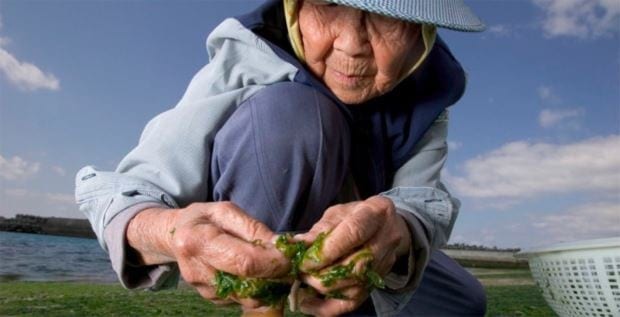
17 Jul The Farming and Banking Blue Zone
Today, Robinson Sewell Partners is bold enough to extend a distinct correlation between characteristics of geographically remote social communities that demonstrate extraordinary physiological traits and that of Wall Street corporates; all in comparison to the deep generational lineage of Australian farmers. The concluding results being a windfall for the Australian banks. An interesting tangential piece that I am sure will intrigue.
Let us begin…
The Blue Zone of Farming & Banking
There is an incredible concentrated list of supercentenarians (age > 110 years) on a little island called Okinowa located in a remote archipelago 640 km south of Japan. The fourth daughter of a draper living in the Tenma district, Misao Okawa was born on the 5th March 1898 and lived to 1 April 2015, an amazing 117 years. Just the history that extended before her must have been an incredible journey. But how did she and many others like her generations before her live that long?
Okinowa is known as a Blue Zone, a place where people literally forget to die. There are a concentrated number of blue zones around the world; Sardinia, Nicoya Peninsula, Ikaria…and believe it against your will, all of which share very similar attributes that can be aspired into world of business.
A lot is to be said about their social culture (moai) and farming practises that entrenches this genetic bypass into superhuman physiology. Resilience, adaptability, flexibility and social unity are core physiognomies that fashion intergenerational sustainability within their farming practises and quality of life. The resulting factor poses a strong argument for their longevity.
The enigmas of their longevity have been passed down from generation to generation, surviving severe climatic and humanitarian adversities and disruptions that only historians can articulate into some form of chaotic order. Perhaps it is a primal pre-condition of survival, but they certainly consist of secrecies that are not naturally inherent within the business world. History can attest this.
The Dow Jones Phenomena
Let’s look at the Dow Jones as a case study. The Dow Jones commenced in 1896 with only 12 industrial members which makes the index 121 years old. Not much older than Misao Okawa. The number of members has now grown and limited to 30, but some intriguing facts throughout its history are as follows;
- Only one original company remains on the Dow Jones: General Electric.
- General Electric is the longest servicing company on the index (110 years). It is the only company that has earned the Blue Zone status. Note: the company had a brief spell off the index early in the 20th Century.
- Over 130 companies have made an appearance on the index, most of which have dropped off, and some have disappeared altogether.
- The Dow’s youngest member is only 30 years old.
- Few notable corporates went bankrupt not long after listing like Kodak and Bethlehem Steel.
 So why is it that corporates, with the financial fire power to attract the smartest minds, fail to sustain Blue Zone longevity against their peers? Is it because they lack the characteristics of their Blue Zone companions (integrated unity, social culture, flexibility, resilience…) or is it because the minds they attract are not so smart?
So why is it that corporates, with the financial fire power to attract the smartest minds, fail to sustain Blue Zone longevity against their peers? Is it because they lack the characteristics of their Blue Zone companions (integrated unity, social culture, flexibility, resilience…) or is it because the minds they attract are not so smart?
To explore this further, let’s look at the lineage of Australian farmers as a comparable study.
Australian Farmers: The Farming Blue Zone
In contrast to the Dow Jones, we have the absolute honour to work with many blue zone Australian farmers, farmers that have passed their business down 4 – 5 generations (> 110 years of continual business). When working alongside these farmers, the following is remarkably evident;
- Farmers in Australia have endured a long history of extreme trading conditions: drought, fire, floods, disease, commodity crashes, pioneering logistics, geographical isolation and political disruption. It could be easily argued that their endurance has been more notable than most traditional corporates. There are numerous recorded events in history that would have disengaged the continual lineage of a family business, but they persevered on.
- That Australian farmers do indeed accompany the blue zone genes of resilience, tenacity, social culture, flexibility and unity. It is these characteristics alone that allow them to move their business through such crippling adversity.
The purpose of farming provides the passion, the social unity provides the support. Just look at the Burrumbuttock Hay Runners as an example.
Burrumbuttock Hay Runners: Brad and Greg Morton
 Concluding Remark
Concluding RemarkIn Australia, we are extremely fortunate to have embellished a culture of financial (and social) survival within our commercial farming community. Our incredible farmers, constituting the guardians of our land mass, have demonstrated time and time again their incredulous ability to adapt and evolve to a forever changing operating landscape. In parallel to the uncontrollable exogenous forces, build sustainable and viable businesses that are passed from one generation to the next.
All I can say is that the Australian banking fraternity is lucky to be banking farmers in the Lucky Country. And may a healthy debate arise on the intrinsic values that underpin the longevity of a farming business, could be considered somewhat undervalued in the modern-day credit assessment process.
Banking the Blue Zone, as history demonstrates, is a strong commercial argument indeed.



Sorry, the comment form is closed at this time.